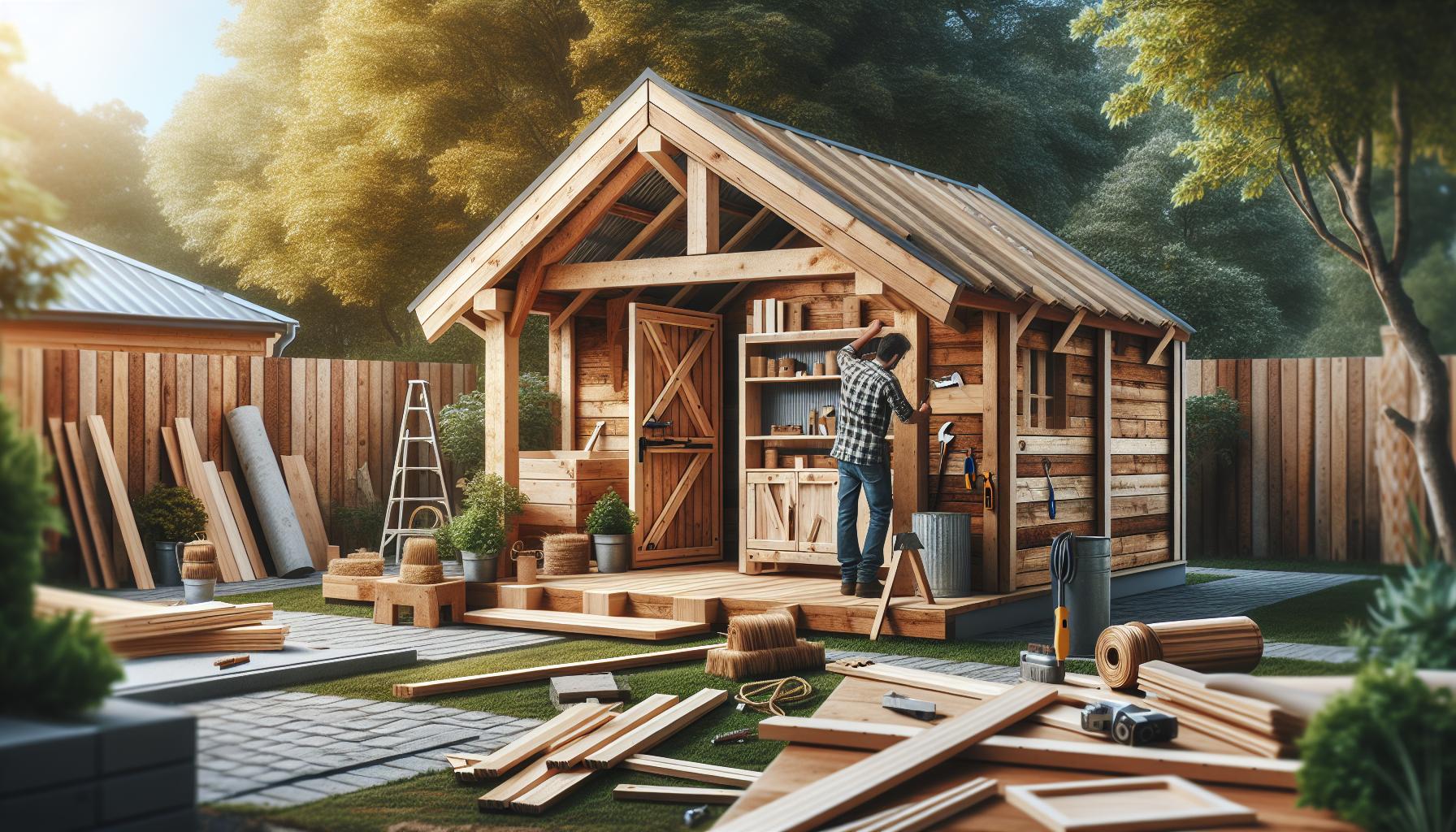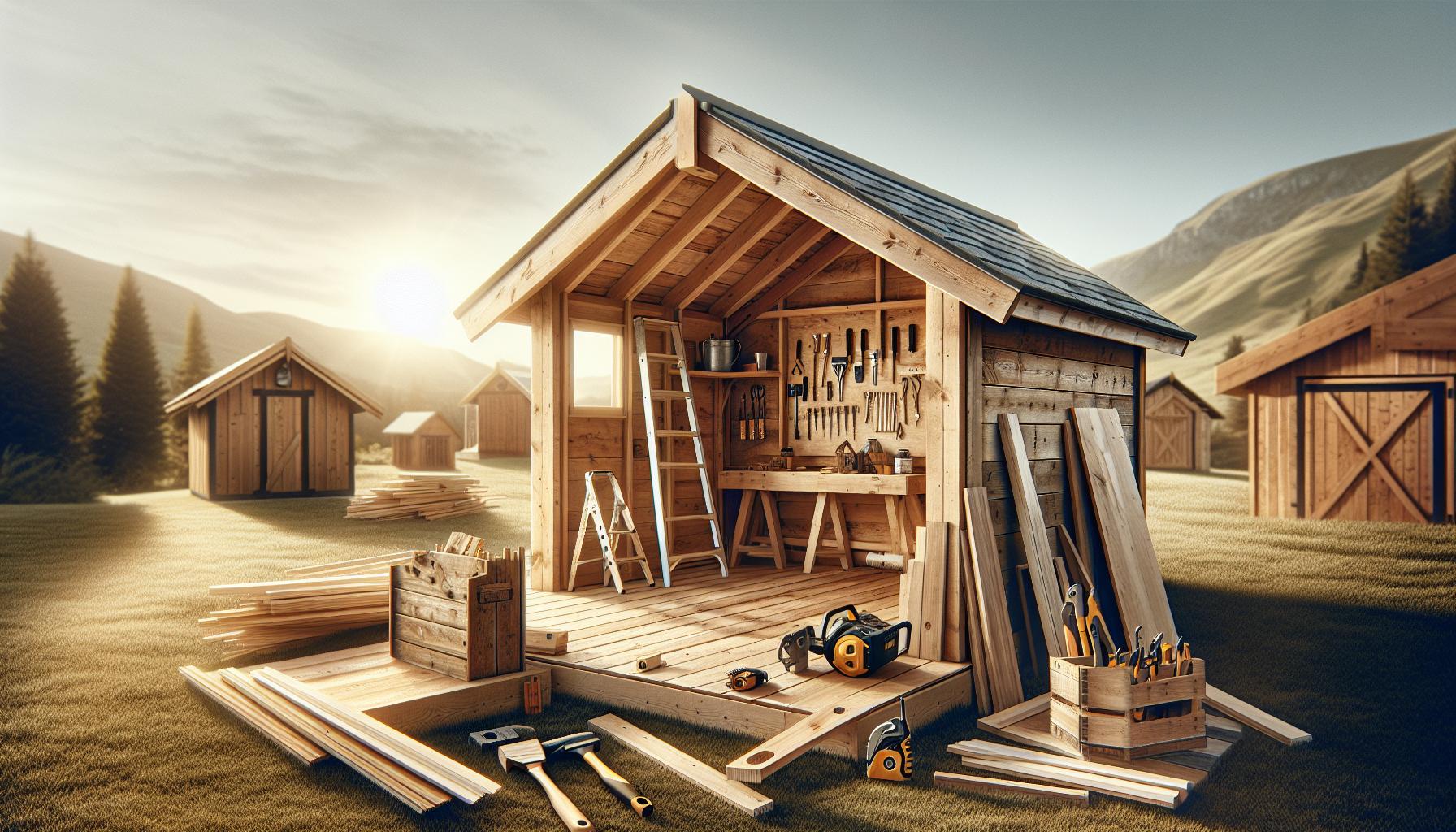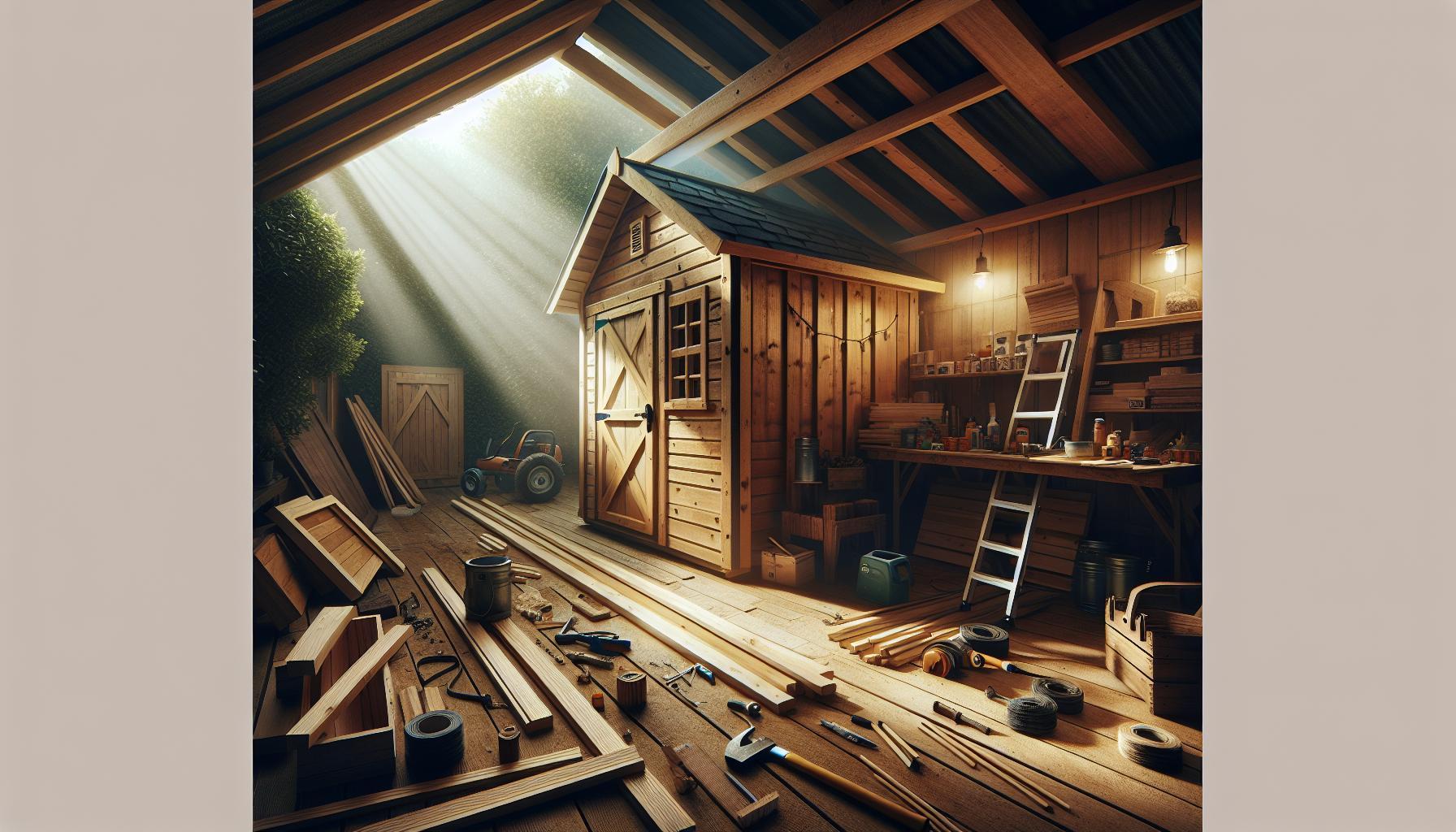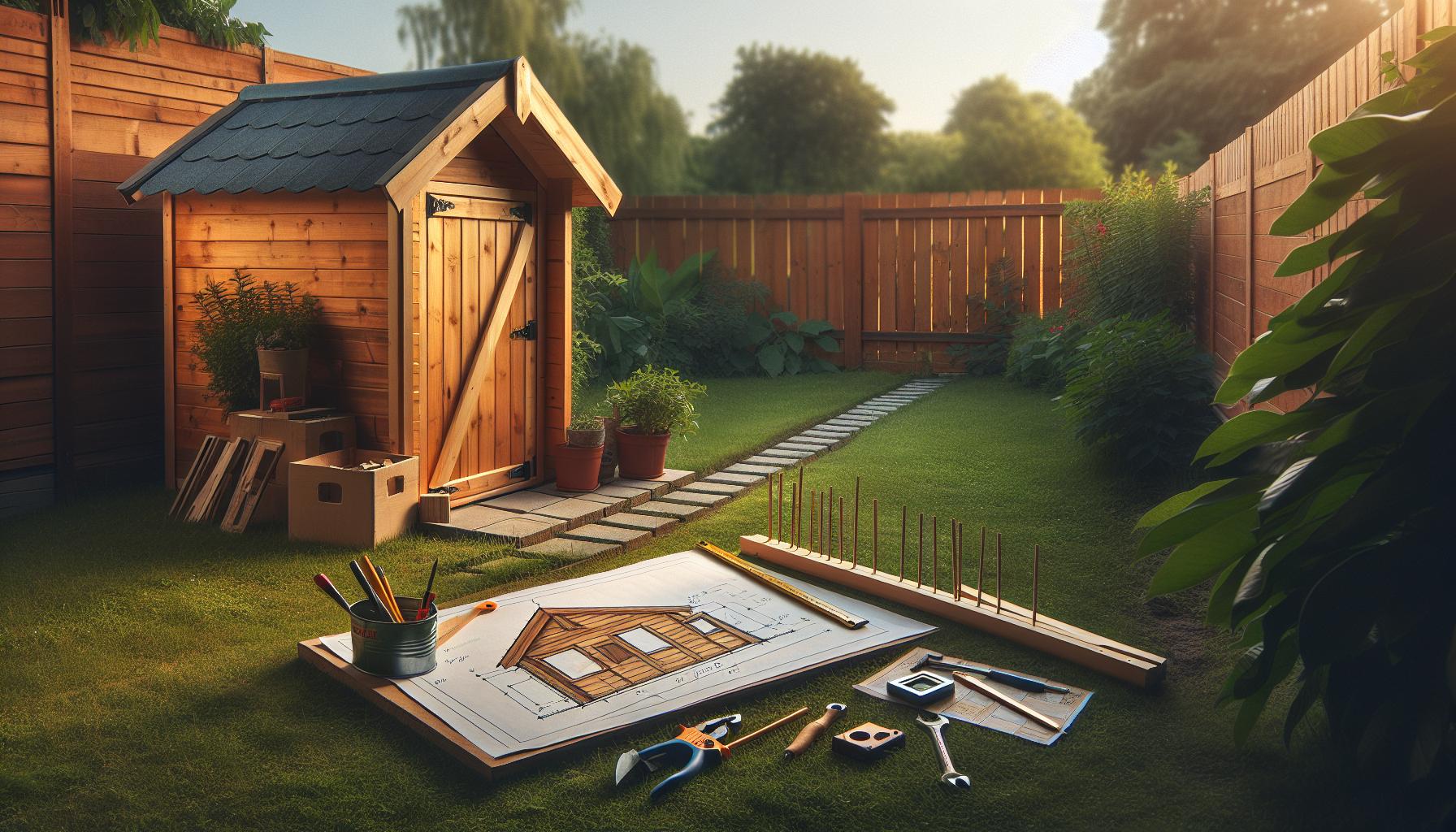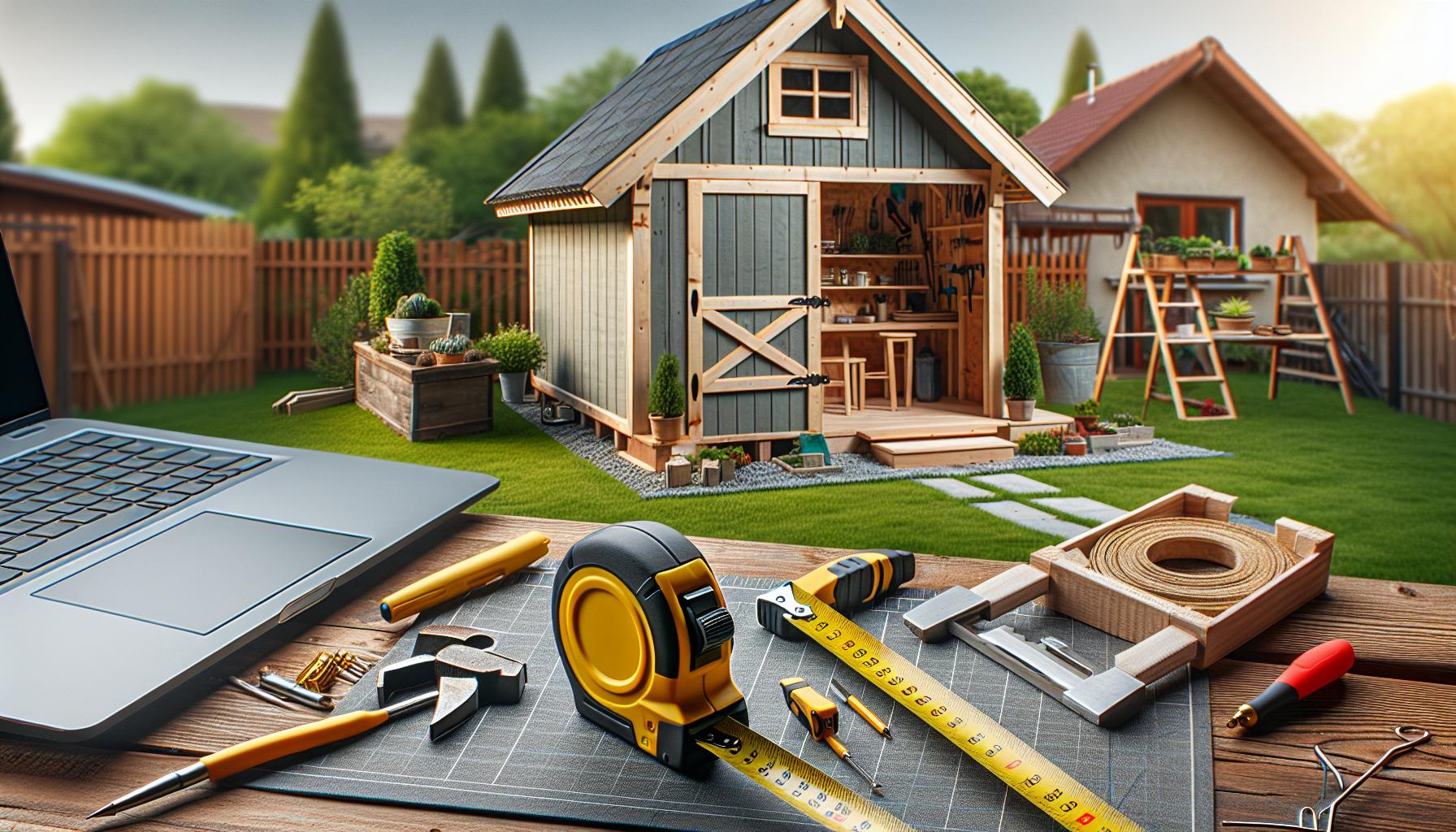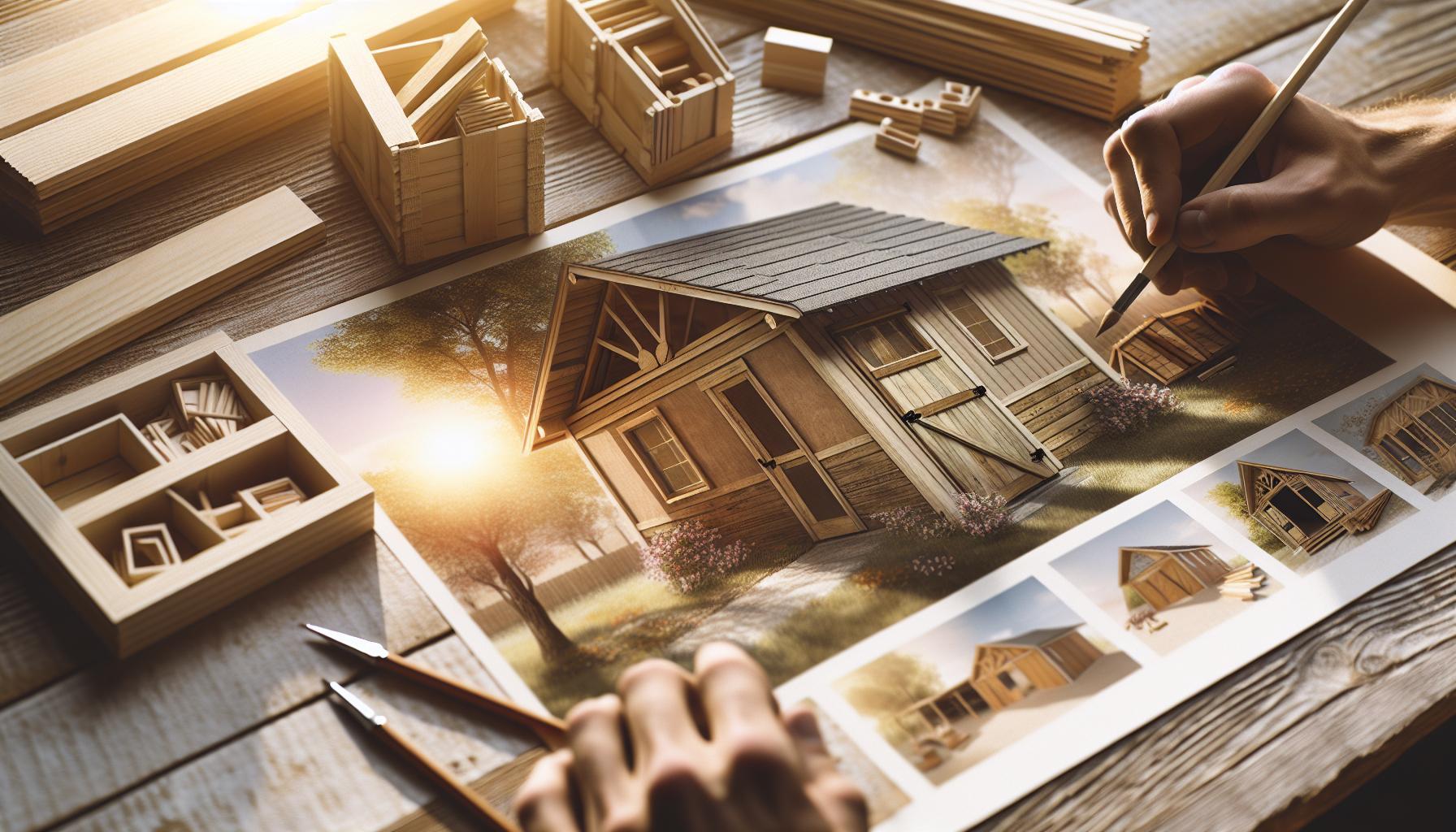Thinking of adding a shed to your backyard? Before you dive into construction, its crucial to understand size limits and permit requirements that can impact your project. Knowing these regulations can save you time, money, and potential headaches, ensuring that your new storage solution complements your space without legal issues.
Understanding local Zoning Regulations for Shed Construction
understanding the nuances of local zoning regulations is crucial for anyone considering the construction of a shed in their backyard. Many homeowners find themselves surprised to learn that the size of their shed and its placement on their property can be heavily influenced by local zoning laws. These regulations can dictate various factors, such as the maximum allowable height, the total square footage of structures, and the distance that a shed must be set back from property lines. Before initiating your construction project, it is essential to familiarize yourself with these details to avoid potential fines or costly alterations.
One key aspect of local zoning regulations is the classification of your property into specific zoning districts, each with unique rules governing structures like sheds. As a notable example, residential zones may allow smaller sheds than commercial or agricultural zones. Notably,many jurisdictions allow sheds under a certain size to be constructed without a permit,while larger structures may require one,alongside plans or inspections. It’s beneficial to check with your local zoning office or utilize online tools to determine your property’s zoning classification and understand the associated regulations.
To help you navigate these zoning requirements, here’s a swift overview of common shed size limits and considerations:
| Property Zoning Type | Maximum Shed Size (Square Feet) | Permit Required |
|---|---|---|
| Residential | 120 – 200 | Depends on size |
| Agricultural | Unlimited (subject to property size) | no |
| Commercial | Varies | Yes |
Before commencing your project, it’s also wise to consult with your neighbors to ensure there are no objections. If your shed might infringe upon their views or uses of shared spaces, it can lead to disputes that complicate your project. Additionally, some neighborhoods have homeowner associations (HOAs) that may have stricter guidelines than local zoning regulations. To summarize, understanding local zoning regulations is foundational in determining how big you can build a shed and ensuring a smooth construction process that adheres to your community’s guidelines.
Typical Size Restrictions: What You Need to Know
Understanding the size limitations when constructing a shed is crucial not only for compliance with local regulations but also for making the most of your space. Many homeowners envision expansive, multi-purpose structures nestled in their backyards; however, these dreams can often be curtailed by size restrictions governed by zoning laws and building codes.
Common Size Limits
Most municipalities impose specific restrictions on the size of structures like sheds to maintain aesthetic uniformity and prevent obstruction of views or sunlight. Here are some typical considerations:
- Maximum Area: Depending on the location, the total area may be capped between 120 to 200 square feet.
- Height Restrictions: Numerous zones limit the height of sheds, typically ranging from 10 to 15 feet to avoid overshadowing nearby properties.
- Setback regulations: Setback requirements dictate how far your shed must be from property lines, often ranging from 3 to 10 feet.
Permit Requirements and Exemptions
Some localities may allow smaller sheds to be built without a permit if they fall below a certain size. For instance, a shed under 100 square feet may not require any permits in some areas, but it’s essential to check your local regulations. here’s a simplified overview:
| Size Category | Permit Required | Typical Size Limit |
|---|---|---|
| Small Shed | No | Less than 100 sq. ft. |
| Medium Shed | Yes | 100 – 200 sq. ft. |
| large Shed | Yes (often more complex) | Over 200 sq. ft. |
Before proceeding with your shed project, understanding these typical size restrictions is vital.Failure to adhere to local guidelines can lead to fines or even the enforced removal of your shed, making preliminary research and planning indispensable in the process of determining how big you can build a shed.
Permitting Process: Navigating the Red Tape
When you’re eager to construct that ideal shed in your backyard, the thrill of planning can quickly fade when you encounter the intricate web of regulations and permits. Many homeowners overlook the crucial step of understanding local zoning laws and building codes, leading to frustrating delays and even legal issues. Unraveling this permitting process is not only necessary but can also turn a daunting task into a manageable one, empowering you to take confident strides in your shed-building journey.
Understanding Local Regulations
Each locality has its own set of rules governing the construction of structures,including sheds. These regulations can dictate the *maximum size*, *setback requirements*, and *material specifications*. Start by checking with your local municipality or zoning office to gather pertinent information about what is allowed in your area.
- Setback Requirements: Knowing how far your shed must be from property lines is crucial.
- Height Restrictions: Many areas impose height limits that can affect the design of larger sheds.
- Permitted Uses: Ensure your intended purpose for the shed aligns with local usage policies.
A valuable starting point for homeowners is checking the official website of their county or city, which often has guidelines and downloadable forms for building permits. Additionally, engaging with community forums or local builders can yield insights that are not readily apparent in official documentation.
The Application Process
Once you’re familiar with the local regulations, the next step involves preparing to submit your permit application. Below is a simplified table to guide you through required documentation and components:
| Documentation Needed | Description |
|---|---|
| Site Plan | A detailed drawing showing where the shed will be located on your property. |
| Building Plans | Blueprints or sketches outlining the shed’s measurements and materials. |
| Permit Fees | Payment of fees required by your local governing body to process the application. |
| Proof of Ownership | Documentation indicating that you own the property where the shed will be built. |
It’s significant to ensure all your documents are accurate and up to date,as incomplete submissions can lead to delays or denials. Misinformation can haunt your shed project; thus, clear communication with the local office during this process is essential.
Navigating the red tape associated with obtaining a building permit can be time-consuming, but understanding the steps involved decreases the likelihood of running into obstacles. Many projects can be completed without a permit if they fall below specific size limits; though,knowing *how big you can build a shed* legally ensures that your hard work doesn’t go to waste. With proper readiness and knowledge,you can turn your vision of a functional,accommodating shed into a reality while adhering to local regulations.
Factors Affecting Shed Dimensions: A Comprehensive Guide
Understanding the various factors that influence shed dimensions is essential for any homeowner considering building a shed on their property. The size of your shed can substantially impact its functionality, aesthetics, and compliance with local regulations. Here’s a closer look at the elements that play a crucial role in determining how big you can build.
Local Zoning Laws and Permits
One of the foremost considerations when planning to construct a shed is the local zoning laws and permit requirements. Each locality may have specific rules that dictate:
- Maximum size limits for sheds
- Height restrictions
- Setback requirements from property lines
Before starting any construction, it’s advisable to check with your municipality regarding these regulations to avoid potential fines or the requirement to dismantle an improperly sized structure. For instance, some areas permit sheds up to 120 square feet without permits, while others might necessitate one for even smaller structures.
Purpose and Use
the intended use of your shed can significantly affect its required dimensions. Here are some examples:
- If you plan to store gardening tools, a smaller shed will suffice.
- A workshop for woodworking projects might require a larger space, ideally between 150 to 240 square feet.
- A shed intended to serve as a guesthouse or studio will require more ample dimensions to ensure comfort.
Consider how you envision using the shed now and in the future to determine the most appropriate size. Building a slightly larger shed than initially planned allows flexibility for various uses.
Property Size and Available Space
Another critical factor in determining shed dimensions is your property size. A small yard might limit the possible dimensions, while larger properties provide more flexibility.However, it’s also important to account for:
- Landscaping and the natural layout of your yard
- Accessibility for construction and future maintenance
- Signs of local wildlife or environmental factors
You might find it beneficial to create a scale drawing that outlines your property and potential shed layouts. This visual can help in planning the exact dimensions while making sure it fits harmoniously within your outdoor space.
Budget and Material Costs
the budget you set aside for your shed can influence its dimensions. Larger sheds require more materials, which translates to increased costs. A practical approach would be:
| Size of Shed (sq ft) | Approximate Cost |
|---|---|
| 100 sq ft | $1,500 – $2,500 |
| 200 sq ft | $3,000 – $5,000 |
| 300 sq ft | $5,500 – $8,000 |
While it’s tempting to opt for the most expansive option within your budget,consider whether you’ll genuinely need that extra space in the long run. adopting a measured approach can lead to both a functional space and financial savings.
determining how big you can build your shed is influenced by a combination of zoning laws, intended usage, lot size, and budget considerations. By carefully evaluating each of these factors, you can design a structure that meets your needs while adhering to local regulations.
Creative Solutions for Expanding Your Shed Space
Understanding the constraints of shed size limits and the maze of permits can frequently enough feel overwhelming for homeowners, but there’s a silver lining in expanding your shed space creatively. Whether you’re looking to store gardening tools, outdoor furniture, or even create a mini workshop, smart solutions exist that can transform even the smallest shed into a functional oasis. By employing innovative design strategies and carefully considering your options,you can significantly maximize your shed’s utility without running afoul of local regulations.
Vertical Storage Solutions
One of the most effective ways to make the most of your shed space is by thinking vertically. Wall-mounted storage systems can definitely help you capitalize on or else wasted vertical space. Consider incorporating:
- Pegboards: Install pegboards on the walls to hang tools, gardening supplies, and small equipment.
- Shelves: Use adjustable shelves for flexible association tailored to your storage needs.
- Hooks and Racks: Heavy-duty hooks can hold larger tools and bicycles off the floor, creating more space.
These enhancements allow you to keep the floor area clear and maintain easy access to your items.
Multi-Functional Furniture
In addition to vertical space optimization, consider investing in multi-functional furniture that adapts to your needs. Here are some examples of furniture pieces that serve dual purposes:
- storage benches: These provide seating as well as hidden storage for gardening tools or outdoor cushions.
- Fold-down tables: Ideal for DIY projects, they can be tucked away when not in use, preserving space.
Integrating these items into your shed can enhance functionality without requiring a larger footprint.
Outdoor Extensions
If building outwards is an option, think about creating outdoor extensions that can complement or expand your shed’s functions. Consider the following concepts:
| Extension Type | Description |
|---|---|
| Paved Patios | Ideal for placing your shed adjacent to a relaxing seating area or fire pit. |
| Overhangs | Provide additional outdoor storage for wood, garden supplies, or tools. |
| Raised Garden Beds | Turn the area around your shed into productive garden space, freeing up indoor storage. |
These outdoor extensions not only expand your usable space but also enhance your property’s value and aesthetic appeal.
Exploring these creative ideas can definitely help you push the boundaries of your shed’s capacity while adhering to established size limits and local permit requirements. By thinking outside the box, you can create a space that is tailored to your lifestyle without the need for extensive renovations or new constructions.
best Practices for Designing a Shed Within Size Constraints
When space is at a premium, it becomes crucial to maximize every square inch, especially when designing a shed. Understanding how size limits and permits influence your planning can be a game changer in achieving both functionality and aesthetics while adhering to necessary regulations.Crafting your design within these constraints doesn’t just require creativity; it involves strategic thinking to ensure that your shed serves its intended purpose effectively.
Maximizing functionality in a Limited Space
designing a shed that optimally fits within your size limitations calls for thoughtful planning.Begin by identifying the primary use of your shed—be it for storage, a small workshop, or maybe even a cozy garden retreat. Once you have this defined, consider the following:
- Vertical Storage: Utilize shelving and wall-mounted racks to draw attention upwards, effectively increasing your storage capacity without expanding your footprint.
- Multi-functional Furniture: Incorporate furniture that serves multiple purposes, such as a fold-down table that can be used for projects or as a workspace.
- Modular Components: Design your interior with adaptable solutions that can change based on your needs, like modular tool storage that can be reconfigured.
Planning your shed with these tips can ensure you utilize every corner effectively without exceeding size limits outlined in your local regulations.
Understanding regulations and Size Limits
Before you begin crafting your shed, familiarizing yourself with local building codes and size limitations is essential. Regulations can vary significantly based on your jurisdiction, affecting the dimensions, height, and placement of your structure. Here’s a simplified breakdown of potential size constraints you may encounter:
| Regulation Type | Example Limitations |
|---|---|
| Footprint Size | Max 120 sq. ft. for non-permitted structures |
| Height Restrictions | Maximum height of 10 feet without special permission |
| setback Requirements | Must be 5 feet from the property line |
Researching these factors can help you plan proactively, avoiding costly mistakes or modifications later on.
Design Aesthetics within Constraints
While adherence to size limits and permits is paramount, don’t overlook the visual appeal of your shed. Thoughtfully chosen materials and colors can make your shed a charming addition to your property. Here are some suggestions to enhance your shed’s aesthetic while respecting its size constraints:
- Color Coordination: Choose colors that complement your home and landscape to create a cohesive look.
- Natural Light: Incorporate windows to bring in natural light, making a small interior feel larger and more inviting.
- Landscaping: Use plants to soften the lines of your shed, integrating it more smoothly with your yard.
By combining functionality, compliance with local regulations, and appealing aesthetics, you can create a shed that not only meets your needs but also enhances the overall appearance of your property.
Planning for Future Growth: Building Bigger with Purpose
Building a shed can be an exciting project, but it also comes with its own set of complexities, especially when considering size limits and local regulations. Knowing how big you can build a shed is crucial not just for compliance, but also for ensuring that your structure meets your needs without running into legal hurdles. Before getting started,it’s essential to conduct thorough research on zoning laws,property lines,and permitting processes. By doing so, you can effectively plan for future growth, maximizing both the utility and value of your investment.
A well-planned shed serves multiple purposes, from storage to workspace, but scaling up requires careful consideration of several factors:
- Local Regulations: Each area has specific zoning laws that dictate the maximum size of outbuildings.Familiarize yourself with these regulations to avoid penalties.
- Permitting Process: Depending on your shed’s planned size, you may need to apply for a building permit. Ensure you have all necessary documentation, including plans that detail the structure’s footprint and height.
- Property Lines: Understanding your property boundaries is essential.Consult with a surveyor if necessary, as building too close to the edge can lead to disputes with neighbors.
- Future Expansion: Consider designing your shed with future growth in mind. As a notable example, if you foresee needing more storage or workspace, allow for easy modifications later.
examples of Shed Size Limits
Determining the appropriate size for your shed can vary widely depending on your location.Here’s a simple overview of typical size limits found in many municipalities:
| Location | Maximum Shed Size | Permit required |
|---|---|---|
| Urban Areas | 100 sq. ft. | Yes, for any size over 100 sq. ft. |
| Suburban Areas | 200 sq. ft. | Yes, typically over 200 sq. ft. |
| Rural Areas | 400 sq. ft. | varies, often depending on total property size |
understanding how big you can build a shed requires a proactive approach to planning and compliance. By taking the time to research local regulations and consider future needs, you not only safeguard against legal issues but also enhance the functionality and longevity of your shed project. As you embark on this endeavor, remember that the right size can significantly impact both your current use and future potential.
Common mistakes to Avoid When Sizing Your Shed
When planning to construct a shed, many homeowners succumb to common miscalculations that can lead to significant setbacks. A well-sized shed not only enhances the functionality of your space but also adds value to your property. Understanding how big you can build a shed, including local size limits and the necessary permits, is crucial in this process. Here are some prevalent mistakes to steer clear of as you embark on this project.
Underestimating Required Space
One of the most frequent blunders is not accurately determining the amount of space you need. Frequently enough, individuals envision their shed to house a lawnmower, tools, or outdoor gear without considering additional space for movement or future items. Failing to account for the following can lead to cramped conditions:
- Storage Needs: Analyze what you plan to store now and in the future.
- Accessibility: Ensure there’s enough room to maneuver items in and out.
- Workspace: If you intend to use it as a workshop,factor in a workbench and walking space.
To better visualize your requirements, sketching a layout can definitely help clarify your needs and minimize the risk of choosing an inadequate size.
Ignoring Local Building Codes
Another critical mistake is overlooking local zoning laws and building codes that impose restrictions on shed sizes.Each municipality has specific guidelines concerning shed dimensions, height restrictions, and the proximity to property lines.
Consider creating a checklist to ensure compliance with local regulations, which may include:
| regulatory Aspect | Details |
|---|---|
| Setback Requirements | Distance the shed must be from property lines |
| Height Restrictions | The maximum height allowed for structures |
| Permit Necessity | Whether a permit is needed based on size thresholds |
Consult with your local building authority before finalizing your shed’s design to avoid costly adjustments later.
Choosing an Inflexible Design
Flexibility in design is essential when sizing your shed. Some owners select a shed that fits their immediate needs but fails to accommodate future changes. This could lead to the need for additional structures later. When determining dimensions, consider:
- Potential Growth: Will your storage needs expand in the coming years?
- Multi-Purpose Use: can the shed serve various functions beyond storage?
- Adaptability: Is there room for modifications or expansions in the future?
Selecting a design with modular elements or open space can make your shed a versatile asset. Planning ahead ensures that your shed will remain useful for years to come, aligning with the broader question of how big you can build a shed based on your unique circumstances.
By avoiding these common sizing errors—underestimating space requirements, ignoring local codes, and selecting inflexible designs—you’ll be well on your way to creating a functional and compliant shed that meets your needs both now and in the future.
Frequently Asked Questions
How Big Can You Build a Shed?
Size limits for sheds depend on local zoning laws and property regulations. Typically,you can build a shed between 100 to 200 square feet without a permit,but this varies by location.
Understanding how big you can build a shed is crucial for compliance and functionality. Many regions allow structures under 120 square feet to be built without formal permits, but checking your local regulations is essential. *Larger sheds may necessitate permits*, so evaluate your specific needs.
For further guidance on permits, refer to our comprehensive article on shed permits.
What is the maximum size for a shed without a permit?
Typically, most municipalities allow a shed up to 120 square feet without needing a permit.However, local laws can vary widely.
It’s important to check with your local zoning office or building department to find out the exact size limits in your area. Many towns have setback requirements that dictate how far a shed needs to be from property lines,which can affect the overall size.
Explore more about this in our shed construction guide for practical insights on navigating the rules.
Why do I need a permit to build a shed?
Building permits ensure that structures comply with safety and zoning regulations, which protects property values and community aesthetics.
obtaining a permit is often a legal requirement for larger sheds. Permits help local officials oversee building safety, ensuring that structures can withstand weather and other environmental challenges. additionally, having a permit can prevent potential fines or complications when selling your property in the future.
For a deeper understanding,check out our section on shed permits.
Can I build a shed on my property line?
Building a shed on your property line is generally not advisable; most locations have setback regulations requiring some distance from property lines.
Setbacks are designed to maintain space between properties for utility access, privacy, and safety. Before starting your project, confirm local zoning laws regarding setbacks; these can vary significantly and might even limit the height of your structure.
Refer to our full guide on property lines and sheds for further details.
What size shed should I build for my needs?
The size of the shed you should build depends on its intended use, such as storage, workspace, or a garden shed.
Consider how you will use your shed. For basic storage, 8×10 feet might suffice, while a workspace or hobby area could require 12×16 feet or more. Think about items you plan to store and whether you’ll need extra room for tools or workspace functionality.
To choose the right size, view our detailed analysis of popular shed sizes.
What are common challenges when building a large shed?
Common challenges include compliance with zoning laws, securing permits, and ensuring structural stability.
Building a large shed can be complicated. Issues like obtaining the right permits and adhering to local regulations can slow down your project. Additionally, larger structures may require a stronger foundation and enhanced framing techniques to support their weight.
Being prepared and informed can smooth the process. For more on avoiding pitfalls, explore our article on shed construction tips.
The Conclusion
understanding the size limits and permit requirements for building a shed is essential for any DIY enthusiast. While the potential for creating a functional and aesthetically pleasing space is exciting, adhering to local regulations ensures your project progresses smoothly and avoids unexpected setbacks. By familiarizing yourself with the specific dimensions allowed in your area and securing necessary permits,you lay a solid foundation for your shed-building journey. Remember,even if obstacles arise—like navigating zoning laws or leveling your site—solution-focused approaches empower you to create your dream shed confidently. We encourage you to dive deeper into the planning stages, explore different shed designs, and don’t hesitate to reach out for guidance as you embark on this fulfilling project. Quality craftsmanship awaits, and you have the tools to make it happen!


